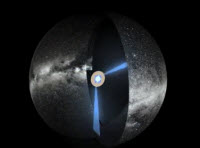 In brief:
In brief:
- Gaia Space Observatory launched, on mission to make an exquisitely accurate map of the Milky Way.
-
A New Method for Measuring Exoplanets' Mass
Launch of Gaia Space Observatory
On Thursday (19th December 2013), Gaia was successfully launched by the European Space Agency (ASA), to map the positions and motions of 1% of the Milky Way's 100 billion stars, to answer questions about the origin and evolution of our home Galaxy.
Gaia has two telescopes with a fixed, 45° angle between them. As Gaia rotates on its axis, it gradually precesses across the sky, measuring the relative positions of objects from both observing directions, to get a positional reference. Gradually a 3D map is built, and the process is repeated around 70 times over five years.
As well as it's primary mission, Gaia will detect planets, asteroids and comets, hunt for ellusive brown dwarf 'almost-stars', and giving yet another test of Einstein's General Relativity by measuring warps in spacetime caused by massive objects.
This Cambridge University (20min) video describes Gaia's mission in detail.
Read More about the Gaia mission:
- Liftoff for ESA's Billion-Star Surveyor (ESA article)
- Gaia Spacecraft (Wikipedia article)
A New Method for Measuring Exoplanets' Mass
To date, over a thousand planets have been discovered orbiting distant stars. With various techniques, astronomers can glean information about the planets' diameter, distance from their host star, and recently even get indications of what they're made of.
They can also measure the approximate mass of a planet, but previous techniques only worked well for large gas-giant planets, and smaller planets orbiting relatively close to their star (like the earth).
The old technique (called 'radial velocity') involves measuring the tiny wobble in a star's orbit caused by the gravitational pull of the planet. But researchers at MIT have found a way to derive a planet's mass from its 'transit signal' - the dip in light as a planet passes in front of its star. This is the measurement which up to now has been useful for measuring a planet’s size and atmospheric properties.
Read more about MIT story:
- New technique measures mass of exoplanets (MIT article)
News in Video
Here's a video summary of this week's news by the Deep Astronomy YouTube channel, which gives much more detailed information of Gaia's launch.
- Log in to post comments

